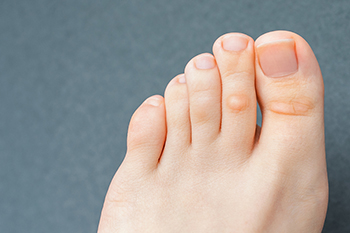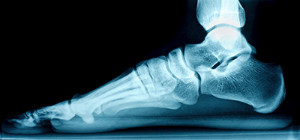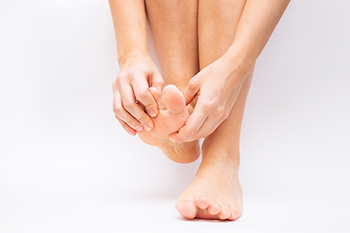3320 North Buffalo Drive
Suite 107
Las Vegas, NV 89129

A foot corn is a thick, hardened area of skin on the foot that usually comes as a result of friction on the feet from shoes. They are the body’s way of protecting the skin underneath. There are a number of methods used to treat corns—from home products for softening the corn like castor oil or pumice stones to surgery. Ways to prevent corns include keeping feet clean, dry, and moisturized. Other methods include wearing comfortable, well-fitting shoes that do not pinch the foot, using corn pads to cover the corn while it is healing, and trimming toenails regularly so pressure that leads to corns does not develop. Usually corns are not serious, however there are times when they can become painful and in need of professional examination by a podiatrist. It is especially important for those with diabetes to consult with a podiatrist at their earliest convenience as they can suffer from numbness and neuropathy. This makes it hard for them to detect a developing infection of the foot.
Corns can make walking very painful and should be treated immediately. If you have questions regarding your feet and ankles, contact one of our podiatrists of Summerlin Foot & Ankle. Our doctors will treat your foot and ankle needs.
Corns: What Are They? And How Do You Get Rid of Them?
Corns are thickened areas on the skin that can become painful. They are caused by excessive pressure and friction on the skin. Corns press into the deeper layers of the skin and are usually round in shape.
Ways to Prevent Corns
There are many ways to get rid of painful corns such as:
Treating Corns
Although most corns slowly disappear when the friction or pressure stops, this isn’t always the case. Consult with your podiatrist to determine the best treatment option for your case of corns.
If you have any questions please feel free to contact our office located in Las Vegas, NV . We offer the newest diagnostic and treatment technologies for all your foot and ankle needs.

When the arch of the foot collapses from birth or from an injury, it is a foot condition known as flat feet. While many patients have this ailment and experience little or no pain, there are people who have severe discomfort with flat feet. Research has shown there are two categories of flat feet. When the arch is flat while standing, and visible while sitting, this is referred to as flexible flat feet, and it is more common than ridgid flat feet. This occurs when there is no arch visible while sitting or standing, and it is more difficult to treat. The majority of babies are born with flat feet, and the arch generally develops during the teenage years. Rigid flat feet can come from genetic reasons, and may indicate an issue with the foot structure. Flat feet in adulthood may develop gradually, and can happen as a result of being overweight, having an inflammatory disease, or sustaining an ankle injury. Mild relief can come from performing exercises that strengthen the foot and from wearing shoes with good arch support. Orthotics may help to improve foot structure and range of motion. If you have flat feet, please speak with a podiatrist who can help you with the correct treatment option.
Flatfoot is a condition many people suffer from. If you have flat feet, contact one of our podiatrists from Summerlin Foot & Ankle. Our doctors will treat your foot and ankle needs.
What Are Flat Feet?
Flatfoot is a condition in which the arch of the foot is depressed and the sole of the foot is almost completely in contact with the ground. About 20-30% of the population generally has flat feet because their arches never formed during growth.
Conditions & Problems:
Having flat feet makes it difficult to run or walk because of the stress placed on the ankles.
Alignment – The general alignment of your legs can be disrupted, because the ankles move inward which can cause major discomfort.
Knees – If you have complications with your knees, flat feet can be a contributor to arthritis in that area.
Symptoms
Treatment
If you are experiencing pain and stress on the foot you may weaken the posterior tibial tendon, which runs around the inside of the ankle.
If you have any questions please feel free to contact our office located in Las Vegas, NV . We offer the newest diagnostic and treatment technologies for all your foot and ankle needs.

Toe pain can range from being irritating to debilitating, and it may be difficult to wear shoes and socks. Common causes for toe pain include bunions, nail conditions, or certain types of arthritis. Toe pain may develop suddenly or gradually, and symptoms can include a burning or prickling sensation. There are 14 bones in the toes, which are surrounded by muscles, tendons, nerves, and blood vessels. An injury to the toe is a common source of toe pain, in addition to having poor circulation. There are specific foot conditions that can cause toe pain, including hammertoe, tendinitis, or Morton’s neuroma. A severe infection may cause extreme toe pain, and could be accompanied by confusion, a high fever, or shortness of breath. Many times a proper diagnosis is performed, which generally consists of having an X-ray taken. Mild relief may come from elevating the affected foot with the shoe removed. If you are experiencing toe pain, please consult a podiatrist who can determine the cause and properly treat it.
Toe pain can disrupt your daily activities. If you have any concerns, contact one of our podiatrists of Summerlin Foot & Ankle. Our doctors can provide the care you need to keep you pain-free and on your feet.
What Causes Toe Pain?
Most severe toe pain is caused due to a sports injury, trauma from dropping something heavy on the toe, or bumping into something rigid. Other problems can develop over time for various reasons.
Toe pain can be caused by one or more ailments. The most common include:
When to See a Podiatrist
Diagnosis
In many cases the cause of toe pain is obvious, but in others, a podiatrist may want to use more advanced methods to determine the problem. These can range from simple visual inspections and sensation tests to X-rays and MRI scans. Prior medical history, family medical history, and any recent physical traumatic events will all be taken into consideration for a proper diagnosis.
Treatment
Treatments for toe pain and injuries vary and may include shoe inserts, padding, taping, medicines, injections, and in some cases, surgery. If you believe that you have broken a toe, please see a podiatrist as soon as possible.
If you have any questions please feel free to contact our office located in Las Vegas, NV . We offer the newest diagnostic tools and technology to treat your foot and ankle needs.

Tennis is a sport that engages your whole body and requires flexibility, strength, and endurance. As a full-body physical activity, tennis can increase a person’s risk of injuring their legs, arms, wrists, back, knees, feet, and ankles. Common tennis injuries in the feet and ankles include tennis toe and ankle sprains. Tennis toe is a simple injury that causes a toenail to hemorrhage when a toe is repeatedly forced up against the shoe’s toe box during the sport’s quick starts and stops. Tennis toe can be avoided by choosing footwear with ample room in the toe box and keeping the toenails properly trimmed. Ankle sprains occur when the ligaments that bind and support the ankle become stretched beyond their normal limits. Again, proper footwear may help to prevent some ankle sprains, specifically, sneakers with extra support in the back of the shoe help to maintain their shape. A podiatrist can treat any foot or ankle injuries that may occur while also offering additional advice on proper footwear and how best to protect yourself from future problems.
Ankle and foot injuries are common among athletes and in many sports. They can be caused by several problems and may be potentially serious. If you are feeling pain or think you were injured in a sporting event or when exercising, consult with one of our podiatrists from Summerlin Foot & Ankle. Our doctors will assess your condition and provide you with quality foot and ankle treatment.
Common Injuries
The most common injuries that occur in sporting activities include:
Symptoms
Symptoms vary depending upon the injury and in some cases, there may be no symptoms at all. However, in most cases, some form of symptom is experienced. Pain, aching, burning, bruising, tenderness, tightness or stiffness, sensation loss, difficulty moving, and swelling are the most common symptoms.
Treatment
Just as symptoms vary depending upon the injury, so do treatment options. A common treatment method is known as the RICE method. This method involves rest, applying ice, compression and elevating the afflicted foot or ankle. If the injury appears to be more serious, surgery might be required, such as arthroscopic or reconstructive surgery. Lastly, rehabilitation or therapy might be needed to gain full functionality in the afflicted area. Any discomfort experienced by an athlete must be evaluated by a licensed, reputable medical professional.
If you have any questions, please feel free to contact our office located in Las Vegas, NV . We offer the newest diagnostic and treatment technologies for all your foot care needs.